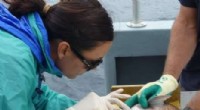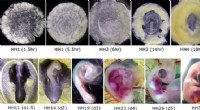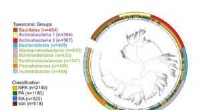
Wetenschap
Components of the cell membrane constantly shift. The model describes this characteristic membrane.?
Dit is waarom:
* Fluid: The phospholipid bilayer, the foundation of the cell membrane, is not rigid. The phospholipid molecules can move laterally within the plane of the membrane, like a fluid. This allows for flexibility and adaptability.
* Mosaic: The membrane is not a uniform structure. It contains a variety of components, including proteins, cholesterol, and carbohydrates, embedded within the phospholipid bilayer. These components are distributed throughout the membrane, creating a mosaic-like appearance.
Key features of the fluid mosaic model:
* fosfolipide dubbellaag: The basic structure, providing a barrier between the cell's interior and exterior.
* eiwitten: Embedded within the bilayer, they perform various functions like transport, communication, and structural support.
* cholesterol: Helps maintain the fluidity of the membrane by preventing it from becoming too rigid or too fluid.
* Koolhydraten: Attached to lipids and proteins, they play roles in cell recognition and signaling.
The constant shifting and fluidity of the membrane allow it to:
* Adapt to changes in the environment: Het membraan kan zijn vorm en samenstelling veranderen in reactie op stimuli, zoals temperatuurschommelingen of veranderingen in de concentratie van bepaalde stoffen.
* Transport molecules: De beweging van eiwitten in het membraan zorgt voor een efficiënt transport van moleculen over het membraan.
* Vergemakkelijk communicatie: De beweging van eiwitten maakt de vorming van signaalcomplexen en de overdracht van signalen over het membraan mogelijk.
Samenvattend biedt het vloeibare mozaïekmodel de meest nauwkeurige beschrijving van het celmembraan, met de nadruk op de dynamische aard en de constante beweging van zijn componenten.
 Wat voor soort binding is een chemische binding die optreedt wanneer atomen elektronen delen?
Wat voor soort binding is een chemische binding die optreedt wanneer atomen elektronen delen?  Wat is het vriespunt van 25,5 C7H11NO7S in 1,00 x 10 2g H2O?
Wat is het vriespunt van 25,5 C7H11NO7S in 1,00 x 10 2g H2O?  Waarom zijn er meerdere redoxreacties in een cel nodig om water te maken uit waterstof en zuurstof?
Waarom zijn er meerdere redoxreacties in een cel nodig om water te maken uit waterstof en zuurstof?  Hoe gooi je bicarbonaat van frisdrank na gebruik weg?
Hoe gooi je bicarbonaat van frisdrank na gebruik weg?  Wat beschrijft het beste hoe een ionci-binding ontstaat?
Wat beschrijft het beste hoe een ionci-binding ontstaat?
Hoofdlijnen
- Zelfverdedigingsstrategieën van mos:scheikundigen ontdekken wat de eetlustslakken bederft
- Uit onderzoek blijkt dat mariene ecosystemen aan de kust die over het hoofd worden gezien meer koolstofdioxide kunnen opvangen dan eerder werd gedacht
- Waarom natuurlijke netwerken stabieler zijn dan door de mens gemaakte netwerken
- Welk dier is meer intresterend?
- Wat is het effect dat enzymen hebben op bepaalde chemische reacties in levende wezens?
- Daar is een studie over:het stenen tijdperk had net zoveel linkse mensen
- Waarom is classificatie belangrijk voor ecologen?
- Zijn weg naar de top vinden:hoe een celoppervlakreceptor zijn bestemming bereikt
- Wat bepaalt de vorm en functie van een eiwit?
- Hoe natuurlijke selectie werkt

- Ter verdediging van kamsalamanders - waarom deze ongrijpbare amfibieën de moeite waard zijn?

- Familiebanden Snapper leveren nieuw bewijs op over mariene reservaten

- Kuikenembryo's leveren waardevolle genetische gegevens voor het begrijpen van de menselijke ontwikkeling

- Een functionele genomics-database voor onderzoeken naar het microbioom van planten

 Mensen zijn bereid meer te betalen om Everglades te beschermen als ze deze twee dingen weten
Mensen zijn bereid meer te betalen om Everglades te beschermen als ze deze twee dingen weten Indringende vraag:Wat is burgerjournalistiek?
Indringende vraag:Wat is burgerjournalistiek?  Hoe circuleert koolstofdioxide tussen een boom en een vos?
Hoe circuleert koolstofdioxide tussen een boom en een vos?  De dag breekt aan in een vierdaagse werkweek
De dag breekt aan in een vierdaagse werkweek Wat zijn tussenliggende rotsen?
Wat zijn tussenliggende rotsen?  Hoe isotopen inzichten in ecosystemen onthullen
Hoe isotopen inzichten in ecosystemen onthullen  Hoe mineraalwater verschilt van gedestilleerd water?
Hoe mineraalwater verschilt van gedestilleerd water?  Grote schakelaar:elektrische auto's zetten China op de autokaart
Grote schakelaar:elektrische auto's zetten China op de autokaart
- Elektronica
- Biologie
- Zonsverduistering
- Wiskunde
- French | Italian | Spanish | Portuguese | Swedish | German | Dutch | Danish | Norway |

-
Wetenschap © https://nl.scienceaq.com

